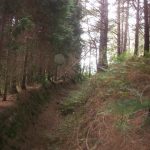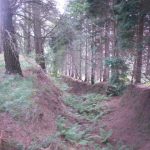 Jon Zuazo, a friend of mine in Munitibar, Bizkaia, just finished renovating his family’s ancestral baserri, Aixabide. He has taken pains to use as much of the original wood as possible, beams that are literally hundreds of years old. In showing me his house, he recounted some of the history, a history that I found both intriguing and very interesting.
Jon Zuazo, a friend of mine in Munitibar, Bizkaia, just finished renovating his family’s ancestral baserri, Aixabide. He has taken pains to use as much of the original wood as possible, beams that are literally hundreds of years old. In showing me his house, he recounted some of the history, a history that I found both intriguing and very interesting.
The baserri has been rebuilt at least twice since it’s founding. The exact date when the original baserri was founded isn’t clear, but it existed at least since 1366. It was originally called Ajorabide, or Ajora’s Way. Ajora was a Basque female name in that era. The baserri was founded with the permission of the local lord, as it was along one of what were known as the Caminos Reales or, in Basque, Errege Bideak, or the King’s Ways. These were roads with special importance for the local economy, in this case, that connected the coast with the interior. Wine was transported from the interior to the coast, and fish was transported in the opposite direction.
Oxen were used to transport the cargo. It turns out that oxen move at the same speed, regardless of the terrain. Thus, these roads were built to be the most direct route between the interior and the coast, going up and over the mountains rather than around. Furthermore, as a team of oxen went the same speed, in a day they went a given distance. At the time, there were lots of, literally, highway robbery and it wasn’t safe for teams to remain outdoors at night. Thus, at in tervals of distances that could be traversed in one day, houses were established at which the teams could stay. At these houses, for a fee, the oxen could be fed and rested and even replaced with a fresh team. For a further fee, the men themselves could find room and board. One of these houses was Ajorabide.
tervals of distances that could be traversed in one day, houses were established at which the teams could stay. At these houses, for a fee, the oxen could be fed and rested and even replaced with a fresh team. For a further fee, the men themselves could find room and board. One of these houses was Ajorabide.
Remnants of these roads can still be seen in the mountains of Euskal Herria. One passes near Munitibar, near Aixabide. Today, it looks like a very deep trench scarred into the earth, overgrown with vegetation, as shown in the two photos. At one time, however, these roads were the lifeblood of trade in Euskal Herria, and more than one baserri was established to facilitate that trade.
Discover more from Buber's Basque Page
Subscribe to get the latest posts sent to your email.

